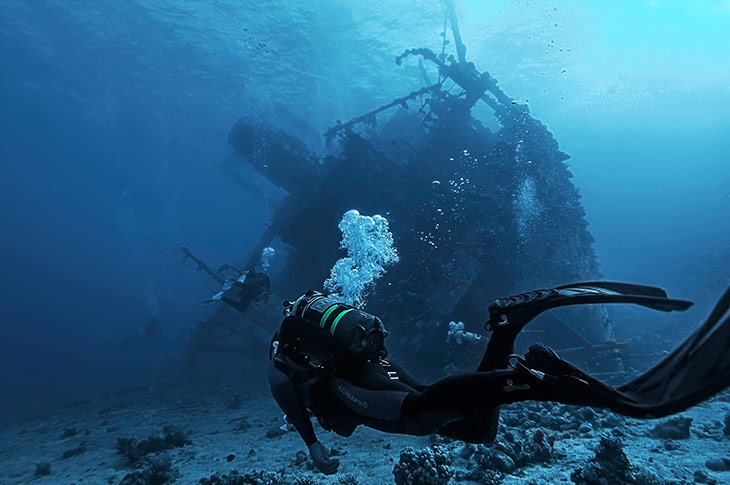PADI Wreck Diver Course
Meet Tom, your diving buddy at the Dive Base Academy of Sindbad Club!
Tom has been diving with Dive Base Academy for four years now. He has completed many PADI courses with us and has become very familiar with numerous dive sites and underwater wonders of the Red Sea. Tom will take you on an exciting tour to familiarize you with our diving courses available at Dive Base Academy. In addition, Tom will act as your trusted host introducing the numerous exciting diving venues the Red Sea offers. So, if you have any questions about our diving courses or dive sites of the Red Sea, please, ask Tom!
Enjoy!
What can you tell us about the wrecks in the Red Sea, Tom?
I have always been fascinated by the presence of so many abandoned wrecks in the Red Sea. Each impact is a mystery, be it a ship, car, motorbike, or plane. Each tells its own intriguing story. Wrecks of any size play with your imagination, each with a historical value or cultural significance to share. They are just fascinating windows to the past.
Why does the Red Sea house so many wrecks, Tom?
When the Suez Canal has been opened, the Red Sea became an important passageway between the Mediterranean Sea and the Indian Ocean. But in those days, better navigation and more reliable maps were required. That's why, so many ships went down and there is an abundance of wrecks there.
Which wrecks did you dive to, Tom?
Well, the number of wrecks in the Red Sea is impressive. Near Hurghada, there is the Belina, the Colona IV, the El Mina and The Excalibur. Near Brothers, Islands are the remains of the Aida and the Numidia. South of Hurghada, you'll find Salem Express and Abu Galawa. North of Hurghada and Shadwan Island, Abu Nuhas is the home of the Carnatic, the Giannis, the Kimo M and the Chrisoula K. The Carnatic was a British cargo passenger ship that had bottled soda water and wine on board when it went down. The wreck is partly covered in a mantle of colorful complex coral formations, thus, is very photogenic for the diving enthusiasts.
The most spectacular wreck dive is the SS Thistlegorm, brought down during World War II by a long-range German bomber. This dive has legendary status among the Red Sea divers. The Thistlegorm lies at a depth of 30m, north of Ras Mohamed in the Strait of Gobal. Nearby, there are also Sarah H/Kingston, the Rosalie Moller and the Dunraven wreck dives that are worthy of detailed exploration.
What impressed you the most, Tom?
Well, first of all, every wreck has its specific charm. But there is one aspect the majority of wrecks have in common. You will almost always find silvery 'clouds' of tens of thousands of darting glassfish and massive shoals of the silverfish. They move around like quicksilver lightning. It is as if you see white curtains blowing in the wind in an open window.
Who is entitled to take the PADI wreck diving course, Tom?
This is a specialty course. You must be at least 15 years of age and have earned a PADI Adventure Diver certification or higher prior to the current course.
What did you learn when you took the course, Tom?
During the practice sessions, the instructor teaches you the safety measures for navigating and exploring wrecks. Personally, I have learned to survey and map impacts. I was also made familiar with the use of penetration lines and reels, which refreshed my skills in using a compass.
Do you need specific attributes, Tom?
Of course, you need your basic scuba equipment and dive light with a backup light, so that you can see inside the wreck. An underwater compass comes in handy for navigation purposes. A reel is also an indispensable tool. Though, you can always ask your instructor for an advice which exact equipment and tools are required for a specific course.
Any advice, Tom, on when to go wreck diving?
Never enter a wreck when you have been instructed not to. Don't try to be a hero. It is as simple as that. Though, wreck diving is great fun, so strictly follow the instructions and enjoy every moment!


